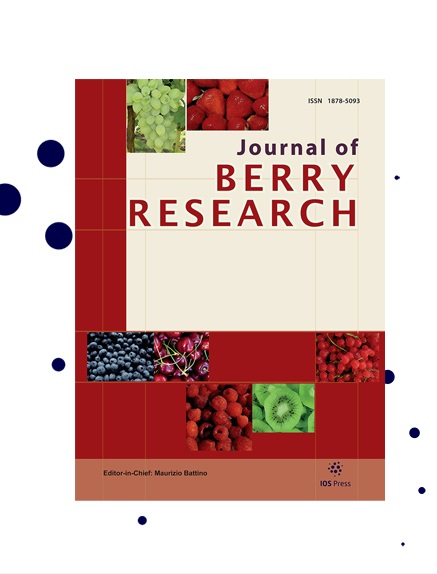Antibacterial properties in-vitro of Mexican serviceberry extracts against dental biofilm species
IF 1.4
4区 农林科学
Q3 PLANT SCIENCES
引用次数: 2
Abstract
BACKGROUND: The Mexican serviceberry, Malacomeles denticulata, have been used as a successful oral therapy by Mexican communities without enough scientific support. OBJECTIVE: To evaluate the M. denticulata extracts with selective antibacterial properties over dental biofilm bacteria. METHODS: Fruit, Leaf, and Stem of M. denticulata extracts were evaluated with micro-broth dilution method using ATCC bacteria. OD600 values had compared against each positive control (T-student-test). Anaerobically viability had confirmed by Colony-Forming-Units. Thin-Layer-Chromatography was used to identify the number of compounds and phytochemicals to identify secondary metabolites of the selected extracts. RESULTS: Streptococcus mutans showed Minimum-Bactericidal-Concentrations_(MBC) at 30 mg/mL to Fruit, Leaf, and Stem extracts. Periodontal-pathogens Aggregatibacter actinomycetemcomitans serotype b_(MBC = 30 mg/mL_NS); Fusobacterium nucleatum subsp. nucleatum_(MBC = 30 mg/mL_p<0.05); Parvimonas micra_(MBC = 15 mg/mL_NS); Porphyromonas gingivalis_(MBC = 30 mg/mL_NS); and Prevotella intermedia_(MBC = 3.75 mg/mL_NS) presented higher sensitivity to Leaf-Methanol, than the primary colonizers. Phytochemicals showed positive results to anthraquinones, coumarins, flavonoids, saponins, saponins steroids/triterpenoids, steroids/triterpenes, and tannins/phenols. CONCLUSION: We suggest the natural extracts of fruit and leaf of the Mexican serviceberry for the preventive use over the oral cariogenic or periodontal biofilm species, by their selective antibacterial properties against pathogenic species evaluated in-vitro, and due to the presence of antibacterial secondary metabolites identified as flavonoids and saponins of M. denticulata leaf extracts.墨西哥服务性浆果提取物对口腔生物膜的体外抗菌性能研究
背景:墨西哥服务浆果Malacomeles denticulata在没有足够科学支持的情况下被墨西哥社区用作成功的口服疗法。目的:评价齿茅提取物对牙生物膜细菌的选择性抗菌作用。方法:采用ATCC菌微肉汤稀释法对小齿茅的果实、叶、茎提取物进行评价。将OD600值与每个阳性对照进行比较(t-学生检验)。菌落形成单位证实厌氧生存能力。采用薄层色谱法对所选提取物的化合物和植物化学物质进行鉴定,并对其次生代谢产物进行鉴定。结果:变形链球菌对果实、叶和茎提取物的最低杀菌浓度为30 mg/mL。牙周致病菌放线菌聚集菌血清型b_(MBC = 30 mg/mL_NS);核梭杆菌亚种nucleatum_(MBC = 30 mg/mL_p<0.05);微细小单胞菌(MBC = 15 mg/mL_NS);牙龈卟啉单胞菌_(MBC = 30 mg/mL_NS);中间普雷沃氏菌(MBC = 3.75 mg/mL_NS)对叶甲醇的敏感性高于原定殖菌。对蒽醌类、香豆素类、黄酮类、皂苷类、皂苷类类固醇/三萜、类固醇/三萜、单宁类/酚类等植物化学成分的检测结果均为阳性。结论:通过体外对病原菌的选择性抗菌性能评估,以及在牙齿木叶提取物中发现的抗菌次生代谢物黄酮类和皂苷类,我们建议墨西哥服务性浆果果实和叶子的天然提取物对口腔龋病或牙周生物膜物种具有预防作用。
本文章由计算机程序翻译,如有差异,请以英文原文为准。
求助全文
约1分钟内获得全文
求助全文
来源期刊

Journal of Berry Research
Biochemistry, Genetics and Molecular Biology-Biochemistry
CiteScore
3.50
自引率
11.80%
发文量
21
期刊介绍:
The main objective of the Journal of Berry Research is to improve the knowledge about quality and production of berries to benefit health of the consumers and maintain profitable production using sustainable systems. The objective will be achieved by focusing on four main areas of research and development:
From genetics to variety evaluation
Nursery production systems and plant quality control
Plant physiology, biochemistry and molecular biology, as well as cultural management
Health for the consumer: components and factors affecting berries'' nutritional value
Specifically, the journal will cover berries (strawberry, raspberry, blackberry, blueberry, cranberry currants, etc.), as well as grapes and small soft fruit in general (e.g., kiwi fruit). It will publish research results covering all areas of plant breeding, including plant genetics, genomics, functional genomics, proteomics and metabolomics, plant physiology, plant pathology and plant development, as well as results dealing with the chemistry and biochemistry of bioactive compounds contained in such fruits and their possible role in human health. Contributions detailing possible pharmacological, medical or therapeutic use or dietary significance will be welcomed in addition to studies regarding biosafety issues of genetically modified plants.
 求助内容:
求助内容: 应助结果提醒方式:
应助结果提醒方式:


